Ok final design is ready, building next week. Very exciting.
So, I am rebuilding these cabs with original Xovers and dimensions, but PPSL. This is what I have come up with. The tweeter looks like a single horn just because thats all i could find to download, but its the right proportion so it gives you the idea.
On reinspection the cabinets did have a vent, no duct. I didnt notice until quite late in the designing, but I am copying the originals so far so I just cut it in half and put half on each side to keep it symmetrical, but I wonder whether this might cause issues, as each half vent is paired to an opposingly phased set of drivers. Might make strange things happen? The vents could be good for un-mounting if needs be...
Also I was wondering whether to keep one phase on each side, or alternate so they are diagonally out of phase as well, I guess I can experiment.
Anyway, input from anyone appreciated before I go ahead next week
So, I am rebuilding these cabs with original Xovers and dimensions, but PPSL. This is what I have come up with. The tweeter looks like a single horn just because thats all i could find to download, but its the right proportion so it gives you the idea.
On reinspection the cabinets did have a vent, no duct. I didnt notice until quite late in the designing, but I am copying the originals so far so I just cut it in half and put half on each side to keep it symmetrical, but I wonder whether this might cause issues, as each half vent is paired to an opposingly phased set of drivers. Might make strange things happen? The vents could be good for un-mounting if needs be...
Also I was wondering whether to keep one phase on each side, or alternate so they are diagonally out of phase as well, I guess I can experiment.
Anyway, input from anyone appreciated before I go ahead next week
Attachments
Very nice work!
One problem though: The high frequency section is supposed to be upright, not on its side as you have designed it in the new enclosure. Have a closer look at the original csx cabinet. I highly recommend you change your design in this regard.
The vent position shouldnt matter, but another option could be on both sides of the hf horn?
Otherwise it looks very good.
You still seem to struggle with the inverted polarity (not phase!!!) concept. Its fairly simple. A loudspeaker moves back and forth. The inverted speakers in the ppsl design have to be wired with inverted polarity, so that they push when the non-inverted ones push, and likewise pull together. Nothing is" out of phase " (n.b. "reverse polarity" is correct). It shouldnt really matter how you mount them, as long as the horizontal pairs are complementary with one inverted, one normal.
One problem though: The high frequency section is supposed to be upright, not on its side as you have designed it in the new enclosure. Have a closer look at the original csx cabinet. I highly recommend you change your design in this regard.
The vent position shouldnt matter, but another option could be on both sides of the hf horn?
Otherwise it looks very good.
You still seem to struggle with the inverted polarity (not phase!!!) concept. Its fairly simple. A loudspeaker moves back and forth. The inverted speakers in the ppsl design have to be wired with inverted polarity, so that they push when the non-inverted ones push, and likewise pull together. Nothing is" out of phase " (n.b. "reverse polarity" is correct). It shouldnt really matter how you mount them, as long as the horizontal pairs are complementary with one inverted, one normal.
Ok I will try and adjust the HF section upright, its a bit awkward but there will be a way.
why is it that they need to be upright, out of interest?
Sorry I see now about phase/polarity! If you wire speakers with inverted polarity, are they not out of phase then? I think thats where my confusion begins, i thought they were the same thing.
a very quick revision - both pretty much the same:
why is it that they need to be upright, out of interest?
Sorry I see now about phase/polarity! If you wire speakers with inverted polarity, are they not out of phase then? I think thats where my confusion begins, i thought they were the same thing.
a very quick revision - both pretty much the same:
Attachments
Ok I will try and adjust the HF section upright, its a bit awkward but there will be a way.
why is it that they need to be upright, out of interest? :
This specific high frequency unit was designed this way. Most hf horns are designed with a "landscape" aspect ratio, but this one is an exception.
Your revised version might work, but from the perspective of acoustic summing it would be optimal if you manage to vertically align them.
Try to optimize for vertical space. For example in your current design the plenum is designed as a self-contained box that is vertically a bit offset from the bottom. You could redesign it so that the bottom of the plenum is formed by the actual bottom board. Make the hf section exactly flush with the upper edge of the plenum. The box will become slender and tall, but it will also be more suitable for groundstacking. Making it again trapezoidal, and maybe a bit deeper could help keep the size and shape manageable.
Sorry I see now about phase/polarity! If you wire speakers with inverted polarity, are they not out of phase then? I think thats where my confusion begins, i thought they were the same thing. :
Don't worry, people are sometimes sloppy with the terminology, which easily leads to confusion. Any instance of polarity reversal should be referred to as such. Two acoustic or electric signals that have complementary polarity, viewed in the phase domain, are 180 degrees relative to each other AT ALL FREQUENCIES.
Usually if you look at acoustic phenomena, the phase relationship is complex and varies by frequency. Referring to polarity reversal as out of phase is bad practice, but common.
Now to get back to the example at hand: All the speakers should move in sync. They should all push together into the plenum for the positive part of the signal, and pull inwards for the negative part. To achieve this, you have to reverse the polarity of the inversely mounted speakers. Its like in math, two negative numbers multiplied result in a positive number.
If you would just connect all the drivers with the same polarity, the inverted drivers would always move opposite to the noninverted ones. The result would be two signals that are of opposite polarity, and massive acoustic cancellation. But when you wire the already inverted drivers in inverse polarity relative to the noninverted drivers, you correct this, and as a result the output from all drivers sums constructively!
I hope this helps
Sorry I see now about phase/polarity! If you wire speakers with inverted polarity, are they not out of phase then? :
Sorry about jumping back to this question, i feel that my previous explanation was inconcise. I neglected to distinguish between electrical and acoustical polarity.
Consider two loudspeakers, both mounted next to each other with magnets inside the enclosure. Connected in same polarity, they both have identical electric and acoustic polarity. If you now flip one of the drivers around and mount it with the magnet outside the enclosure, but keep the wiring the same, the loudspeakers will remain in same electric polarity, but the acoistic output from the drivers will be of opposite polarity. If you now flip the electrical polarity of the reverse mounted driver (i.e. Swap + and -), the acoustic polarity of the drivers will match again.
All this is possible because audio signals and sound are ac in nature, and loudspeaker voice coils dont really care in which polarity they are connected to amps. So in the electrical domain you can flip polarity as required, and for example connect multiple loudspeakers in series or parallel with different electric polarity, as long as the acoustic output is correct in the end.
Im just glad you have a motive to be so patient!
Sharing whatever humble knowledge one has is highly rewarding if there is a receptive recipient
I do have some recording equipment, ie. a good condenser microphone and high quality interface. What else would I need, some clever software?
There is a nice free software called roomeqwizard which is a good start.
Depending on the model of your condenser mic, it might do for some basic testing. Which model is it exactly?
GodspeedGoing to go back to the design now and see if I can make it work as a tall box
receiving loud and clear and gratefully!
its an AKG C2000 B - i think, from a quick google image search. I havent used it for a while. Nothing too fancy but not bad either.
here is version 2.0 - a bit taller, same bracing as original, 'dual vent'...
its an AKG C2000 B - i think, from a quick google image search. I havent used it for a while. Nothing too fancy but not bad either.
here is version 2.0 - a bit taller, same bracing as original, 'dual vent'...
Attachments
Last edited:
Still very glad to help, and Wow, excellent work!!!
The akg c2000 is a good mic, but not well suited for acoustic measurements since the capsule is rather large, and it is a cardioid. There are affordable measurement mics with entry pricing around 50€/$ (btw, where are you geographically?).
I would recommend to look for a vendor that provides individual calibration files for each mic, compared to a known reference. This calibration file is loaded into the measurement software, and compensates for freq response deviations of the mic.
The akg c2000 is a good mic, but not well suited for acoustic measurements since the capsule is rather large, and it is a cardioid. There are affordable measurement mics with entry pricing around 50€/$ (btw, where are you geographically?).
I would recommend to look for a vendor that provides individual calibration files for each mic, compared to a known reference. This calibration file is loaded into the measurement software, and compensates for freq response deviations of the mic.
you can have reasonable quality under 100 pounds easily:
Messmikrofon ECM-40 – HiFi-Selbstbau-Der Shop
95 euros for the mic + calibration file. I have bought this and am very happy with the results.
Messmikrofon ECM-40 – HiFi-Selbstbau-Der Shop
95 euros for the mic + calibration file. I have bought this and am very happy with the results.
Or, to start with, this one:
Superlux ECM999 – Thomann Österreich
Bear in mind that most measurement mikes need phantom power.
Superlux ECM999 – Thomann Österreich
Bear in mind that most measurement mikes need phantom power.
here is version 2.0 - a bit taller, same bracing as original, 'dual vent'...
Ok, now I'll just lean back, awaiting sawdust, pictures, and a full report.....
- Status
- This old topic is closed. If you want to reopen this topic, contact a moderator using the "Report Post" button.
- Home
- Live Sound
- PA Systems
- Frankensoundsystem Bodge - Is it worth it?!
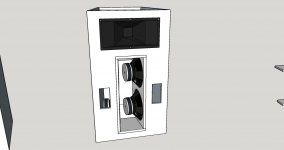
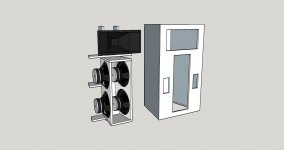
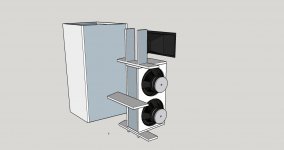
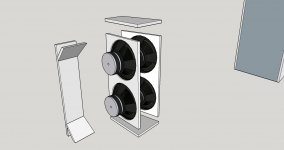
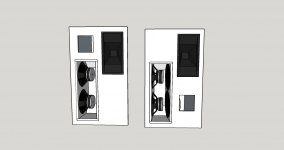
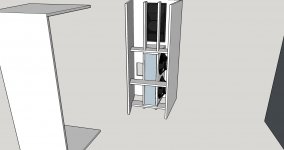
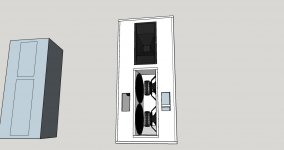
 In case you haven't found it yet here is a link to
In case you haven't found it yet here is a link to